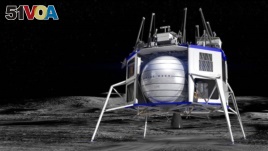30 August 2020
A full-size model of a privately-developed moon lander has arrived at the U.S. space agency NASA for examination and testing.
The model, also known as a mock-up, stands more than 12 meters high. The design represents one of three lunar landers being developed for NASA by three different companies.
The mock-up was recently sent to NASA's Johnson Space Center in Houston, Texas. Blue Origin, a Washington state-based space flight company, produced it.
NASA announced earlier this year it had chosen three American businesses to develop, build and fly lunar landers for future missions to the moon. The other two companies are California's SpaceX and Dynetics of Alabama.
SpaceX made history in May by launching two astronauts into space aboard a spacecraft the company built and operated for NASA. It was the first time astronauts had launched from American soil since the last space shuttle flight in 2011.
Altogether, NASA has agreed to pay the three companies $967 million to design and develop human landing systems for its Artemis program. The goal of Artemis is to return astronauts to the moon in 2024, NASA officials have said.
The space agency's next goal is to establish a long-term base on the moon by 2028. From there, NASA says it hopes to launch a series of space operations, including missions to Mars.
Blue Origin's model is not a working version of the lander. But it does include full elements designed to give NASA engineers an up-close look at the landing system.
One of the main goals of the mock-up operation will be to test how effectively the lunar lander can get crew, equipment and supplies on and off of the vehicle, Blue Origin said in a statement. It will also be a chance for astronauts to examine the equipment and provide their feedback on the design.

Shown is an artist's concept of a Blue Origin commercial lunar lander on the Moon. Blue Origin was one of five companies announced on Nov. 18, 2019, as taking part in NASA's Commercial Lunar Payload Services or CLPS initiative. (Image Credit: Blue Origin
Blue Origin formed a "National Team" with other companies to work on the lunar lander project. The team includes Lockheed Martin, Northrop Grumman and Draper.
The system is based on three main parts: the Ascent Element, the Descent Element and the Transfer Element.
Lockheed Martin is designing the Ascent Element, where the crew would be housed during moon missions. The Descent Element, developed by Blue Origin, would carry the astronauts to the surface of the moon. The Transfer Element, designed by Northrop Grumman, links up with the lander and would guide the crew through low lunar orbit in preparation for landing.
Leaders of the National Team say they decided to create the three lander components to speed up the design and development process. This method permits the team to carry out independent development and testing of individual elements, without affecting the full system, Blue Origin said.
Both the Ascent Element and the Descent Element were sent to NASA for examination and testing.
Brent Sherwood is vice president of Advanced Development Programs for Blue Origin. "Testing this engineering mock-up for crew interaction is a step toward making this historic mission real," he said in a statement.
He noted the importance of receiving NASA's expertise and feedback on Blue Origin's design as early as possible to help improve the overall development progress. "The learning we get from full-scale mock-ups can't be done any other way," Sherwood added.
I'm Bryan Lynn.
Bryan Lynn wrote this story for VOA Learning English, based on reports from Blue Origin and NASA. Caty Weaver was the editor.
We want to hear from you. Write to us in the Comments section, and visit 51VOA.COM.
________________________________________________________________
Words in This Story
mission – n. an important task, usually involving travel somewhere
feedback – n. helpful information or criticism that is given to someone to say what can be done to improve a performance or product
component – n. one of the parts of something, especially a machine
full-scale – adj. very large or serious and involving everything that is possible or expected